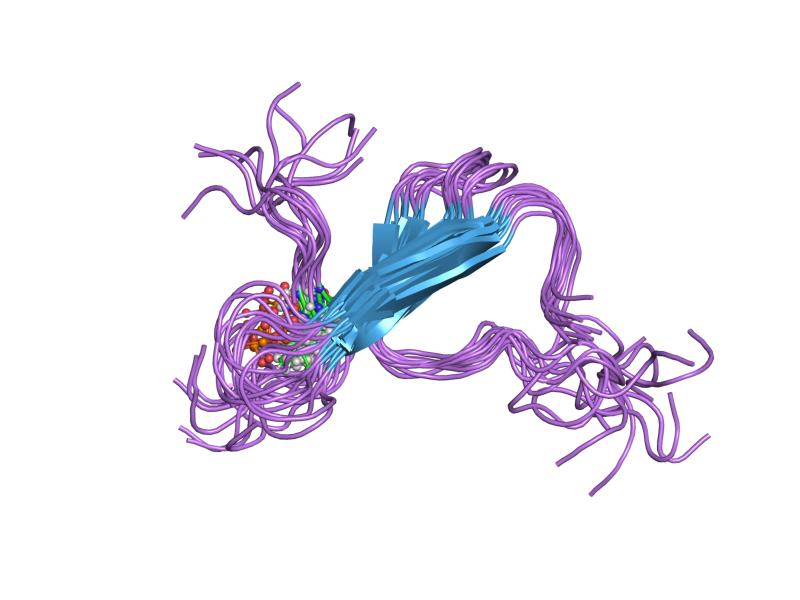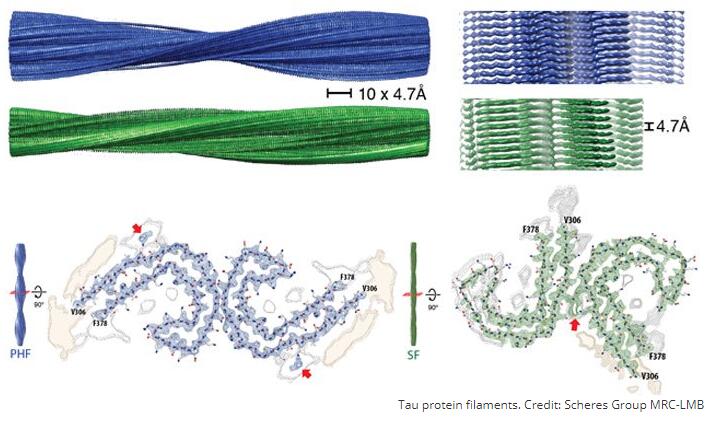Tau protein abnormal deposit is one of the most important characteristics for Alzheimer. Recently, a new finding published in Nature obtained high-resolution images of those protein deposit structures caused by Alzheimer and other neurodegenerative disease for the first time. These finding can help scientists understand how these protein harmful deposit process function at the molecular level, and help develop new treatments to prevent the formation of these proteins, and thus treat Alzheimer’s disease and dementia.
Alzheimer is a common neurodegenerative disease, and, at pathogenesis level, there is no cure method now. The occurrence of Alzheimer’s disease is related to the abnormal accumulation of two proteins. One is Tau protein accumulation inside the neuronal cell and the other is amyloid beta protein deposited outside the neuronal cell. There are neuronal injury and neuritic plaques in patient’s cerebral cortex and their nerve fibers are damaged by paired Tau protein fibers which are tangled together. The Tau protein fibers also appear in the brain of other neurodegenerative patients.
Fig1. Tau protein (from wiki)
In healthy brains, the original function of the Tau protein is to maintain the stability of the microtubules. But when the Tau protein become defective, it forms a bundle of intertwined nerve fibers, which are thought generally to interfere the transmission of information between brain cells. That’s how the Tau protein cause the nerve degeneration and cognitive decline in Alzheimer’s symptoms.
In this study, the researchers, led by the MRC Laboratory of Molecular Biology (LMB) in the UK, extracted Tau protein from the patient’s brain which confirmed diagnosis of Alzheimer and captured high-resolution Tau protein images by using cryo-electron microscopy (cryo-EM) technique.
Scientists have been studying the relationship between Tau protein and Alzheimer’s disease for a long time. But up until now, they’ve never been able to study Tau protein fibers so close. Current low temperature microscopic imaging technique with resolution of 3.4-3.5 Å provides opportunities for drug discovery which combats with Tau protein deposit go to a new era.
Understanding protein complexes helps drug research and development
“This is a tremendous step forward,” says one of the team, Bernardino Ghetti from Indiana University. “It’s clear that tau is extremely important to the progression of Alzheimer’s disease and certain forms of dementia. In terms of designing therapeutic agents, the possibilities are now enormous.”
“Drugs that could clear away clumps of protein in the brain are a key goal for researchers, but to directly affect these proteins, molecules that make up a drug need to latch on and bind to their surface,” explains the head of research at Alzheimer’s Research UK, Rosa Sancho. “Knowing the precise shape of these complex protein structures is enormously valuable in guiding the development of targeted drugs.”
A considerable number of scientists have studied how abnormal Tau and beta-amyloid proteins have led to disease. But these findings are often questioned because we cannot determine whether the structure difference between protein synthesized in the laboratory and formed in the human body is small enough to have a reference value.
In this study, because the researchers obtained the Tau protein from the deceased patient, researchers now have the ability to investigate how abnormal filaments function at an atomic level in the human brain – and studying these tangles won’t only benefit Alzheimer’s research, the team says. “This is a big step forward as far as tau goes but it is bigger than that.” Michel Goedert, a neurobiologist at the British Molecular Biology Laboratory, says “This is the first time anybody has determined the high-resolution structure from human brain samples for any of these diseases. The next step is to use this information to study the mechanisms of neurodegeneration.”
Although we cannot predict what results scientists will finally get from this study, it is certainly an influential turning point. Ghetti said this study was one of the most important discoveries on Alzheimer in last twenty years, which changed the related research direction into protein deposit harmful to human.
It may take many more years (or even decades) for new treatments to ultimately come out of this – but at least we’re now a big step closer to that long-hoped-for eventuality, which before now may have been impossible.
“It’s like shooting in the dark – you can still hit something but you are much more likely to hit if you know what the structure is,” explains one of the team, LMB’s Sjors Scheres. “We are excited – it opens up a whole new era in this field, it really does.”

